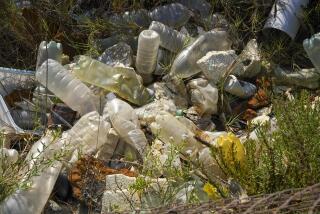Old Plastic Finds a New Way of Life : Recycling: Today’s entrepreneurs eye plastic trash as a chief component in recycled products.
- Share via
AKRON, Ohio — Next time you head out to commune with nature and spread your lunch on a picnic table, you may actually be eating on a bunch of old milk jugs.
Plastic lumber is being used for mailbox posts and other items, as well as picnic tables.
“You’re looking at a product you never have to paint, never have to sand. No splinters,” said Alan E. Robbins, who hopes to parlay his marketing background, a glut of used plastic and increased interest in recycling into a future for plastic lumber.
Robbins figures he safely disposes of 1,500 plastic milk jugs every time he turns out a picnic table. But plastic lumber is more than twice as expensive as tree lumber--and it isn’t strong enough to meet building codes and qualify for use in framing houses.
Robbins’ Plastic Lumber Co. Inc.--in a low-rent former B.F. Goodrich plant--opened in June 1989. Robbins said he began turning a profit earlier this year but still handles sales himself, mostly to bulk buyers such as city park agencies.
His operation has a higher-profile, better-financed competitor, Hammer’s Plastic Recycling Corp. of Iowa Falls, Iowa, which has announced plans to add 16 recycling centers within two years.
Richard Heller, chief operating officer of Hammer’s, said the 3-year-old company uses 500,000 pounds of recycled plastic monthly. It has 90 employees and has patented molding and steel reinforcing techniques. Plastic Lumber, by comparison, uses 3 million pounds of plastic a year and has nine employees.
Heller said Hammer’s is the biggest of fewer than a dozen American companies devoted to making products from recycled plastic.
With 95% of America’s 63 billion pounds of plastic used each year suitable for recycling, Robbins figures he has an unlimited supply of raw materials.
Both Hammer’s and Plastic Lumber focus on items like picnic tables, park benches, mailbox posts and parking lot car stops.
Although plastic lumber costs more, Robbins says customers get more for their money, including durability and easy maintenance. His picnic table sells for $189 wholesale.
Pat Linehan, a buyer with the purchasing department for the city of Syracuse, N.Y., has placed nearly $2,000 in orders with Plastic Lumber, mostly for curb edgings for a police garage.
“I think the concept is a great idea, and I jumped right on it because I like to see the recycling effort,” he said. Linehan said the real test for the curb edgings would be whether they withstand wear and tear from snow plows and salting.
To produce plastic planks, Robbins’ staff feeds half-ton cartons of recycled plastic, already ground into the consistency of oatmeal, into a mixer. Colors are added and the material is melted at 400 degrees and poured into molds. The molded plastic planks are cooled in water chilled with power from the city’s nearby trash-to-steam plant.
Robbins said his method, which isn’t patented yet, improves the cold-weather strength of plastic and allows it to absorb heat more evenly. The slick surface of plastic lumber resists graffiti, but it also doesn’t take any paint well.
More to Read
Inside the business of entertainment
The Wide Shot brings you news, analysis and insights on everything from streaming wars to production — and what it all means for the future.
You may occasionally receive promotional content from the Los Angeles Times.








